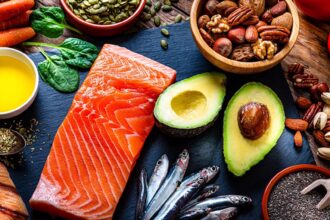Maintaining healthy and strong bones becomes increasingly important once you cross your 40s. Natural ageing, hormonal changes, and lifestyle habits all affect how quickly bones lose density. The good news is that simple, sustainable daily habits can significantly improve bone strength, reduce fracture risk, and help prevent osteoporosis. In this guide, you will learn practical steps you can follow every day to strengthen your bones naturally and support long-term skeletal health.
Why bone health declines after 40
Bone density naturally peaks around age 30. After 40, the rate of bone loss gradually increases. This happens for several reasons:
- Hormonal changes, especially in women during perimenopause and menopause
- Decreased calcium absorption from food
- Reduced muscle mass, which leads to reduced bone stimulation
- Slower cell regeneration in bones
- Lifestyle factors such as stress, poor diet, or inactivity
Early signs of weakening bones may include frequent aches, back pain, reduced height, poor posture, or fractures from minor falls. Building strong daily habits can slow down this decline and protect your bones well into older age.
How to make bones strong after 40
Strengthening your bones after 40 requires a balanced approach that includes diet, exercise, lifestyle changes, and proactive health management. Here are key daily practices to follow.
Maintain a nutrient-rich diet every day
A healthy diet is the foundation of stronger bones. Your meals should be rich in calcium, vitamin D, protein, magnesium, zinc, and vitamin K2. These nutrients help build new bone cells and maintain bone density.
Examples of nutrient-rich foods include leafy greens, fortified cereals, yogurt, almonds, tofu, eggs, fish, and seeds. Drinking enough water and limiting caffeine or salty foods also helps support bone health. High-sodium diets can lead to calcium loss, while too much caffeine can interfere with calcium absorption.
Establish consistent exercise habits
Daily or regular physical activity is essential for stimulating new bone growth. Weight-bearing and strength-training activities enhance bone density and improve muscle support.
Aim for at least 30 minutes of movement every day, mixing walking, resistance exercises, and flexibility workouts. Exercise also improves balance, helping reduce fall-related injuries in your 40s and beyond.
Prioritise sleep and stress control
Hormonal imbalance caused by stress can weaken bones. Cortisol, the stress hormone, may increase calcium loss and slow bone formation. Aim for 7–8 hours of quality sleep each night and practise stress-reducing activities such as yoga, meditation, slow breathing, or light stretching.
Avoid habits that weaken bones
Certain lifestyle choices can accelerate bone loss. These include:
- Smoking
- Excessive alcohol consumption
- Lack of sunlight exposure
- Poor diet low in essential nutrients
- Sitting for long periods
Being mindful of these habits and replacing them with healthier routines will make a significant difference in long-term bone strength.
Exercises for stronger bones after 40
The right types of exercises can help you maintain and improve bone density. These exercises work by applying stress to the bones, stimulating them to grow stronger.
Weight-bearing exercises
These exercises require you to move your body against gravity while staying upright. Good examples include:
- Brisk walking
- Jogging or light running
- Hiking
- Dancing
- Stair climbing
Doing these activities regularly helps improve bone mass in the hips, spine, and legs.
Strength training routines
Strength training increases muscle mass, which provides better support to bones. It also stimulates bone growth by applying controlled pressure to the skeletal structure.
Effective strength-training exercises include:
- Squats and lunges
- Resistance band workouts
- Dumbbell exercises
- Push-ups and planks
Aim for at least two to three sessions per week. Start light and gradually increase intensity.
Balance and flexibility workouts
Improving balance lowers the risk of falls and fractures. Flexibility exercises help keep joints healthy and aligned.
Great options include:
- Yoga
- Tai Chi
- Pilates
Practising these a few times a week enhances mobility while supporting bone health.
Calcium rich foods for bone health
Calcium is the primary building block of bones. After age 40, adults need around 1,000–1,200 mg of calcium daily.
Top calcium-rich foods
Include a mix of these in your daily diet:
- Low-fat dairy products (milk, yogurt, cheese)
- Leafy green vegetables (kale, spinach, bok choy)
- Nuts and seeds (almonds, chia seeds, sesame seeds)
- Tofu and soy-based foods
- Sardines or salmon with bones
- Fortified plant-based milks and cereals
Foods that enhance calcium absorption
Pair calcium foods with vitamin D, magnesium, and vitamin K2 to boost absorption. Foods such as eggs, mushrooms, bananas, avocados, and fermented soy products support overall bone health.
Foods to avoid for better bone health
Some foods can inhibit calcium absorption, including:
- High-sodium processed foods
- Cola drinks
- Excess caffeine
- Highly processed snacks
A balanced and nutrient-rich diet makes calcium work effectively to strengthen bones.
Importance of vitamin D for bone strength
Vitamin D plays a crucial role in helping your body absorb calcium. Without enough vitamin D, even a high-calcium diet won’t protect your bones properly.
Why vitamin D is essential
- Supports calcium absorption from the intestines
- Enhances bone mineralisation
- Prevents bone softening and weakening
- Helps maintain muscle function
Sources of vitamin D
You can boost your vitamin D levels through:
- Sun exposure for 10–30 minutes a few times a week
- Foods such as eggs, fortified milk, fatty fish, and mushrooms
- Supplements, if recommended by a healthcare provider
Since vitamin D deficiency is common in adults over 40, maintaining daily exposure to sunlight and vitamin D-rich foods is essential.
How to prevent osteoporosis after 40
Osteoporosis is a condition where bones become brittle and prone to fractures. Preventing it early can significantly improve long-term bone health.
Key prevention strategies
- Maintain a calcium- and vitamin D-rich diet
- Engage in weight-bearing and strength-training exercises
- Avoid smoking and limit alcohol
- Manage stress and maintain hormonal balance
- Maintain a healthy weight
- Monitor bone density regularly, especially if you have risk factors
If you have pre-existing health conditions or a family history of osteoporosis, speak with your doctor for personalised guidance.
Increase bone density naturally with daily habits
You can naturally support bone density using simple daily practices. These include:
- Eating nutrient-dense meals
- Staying active and exercising regularly
- Spending time in sunlight for vitamin D
- Reducing inflammatory foods
- Ensuring balanced protein intake
Magnesium, zinc, omega-3 fatty acids, and vitamin K2 also play important roles in maintaining bone strength. Adding foods like nuts, seeds, fish, and fermented foods to your diet provides essential nutrients for healthy bones.
Other essential nutrients for bone health
Beyond calcium and vitamin D, several other nutrients support bone strength.
Protein
Protein helps form the structure of bones. Include lean meats, dairy, legumes, and nuts in your meals.
Omega-3 fatty acids
Omega-3 reduces inflammation, which may help protect bone tissue. Good sources include salmon, walnuts, and flaxseeds.
Vitamin K2
Vitamin K2 helps direct calcium to bones instead of arteries. It is found in fermented foods such as natto, cheese, and some dairy products.
Zinc and magnesium
These minerals assist bone repair and vitamin D activation. Nuts, seeds, bananas, whole grains, and leafy greens are excellent sources.
A balanced diet ensures that all essential nutrients contribute to stronger bones.
Best lifestyle habits for bone strength
Healthy lifestyle habits support bone health as much as diet and exercise.
Daily habits that promote strong bones
- Getting morning sunlight exposure
- Staying hydrated throughout the day
- Using proper posture while sitting or standing
- Taking breaks to move every hour
- Including movement in daily tasks such as gardening or walking
- Doing low-impact stretches for flexibility
These small but consistent habits create a healthier environment for your bones.
When to see a doctor
You should seek medical advice if you notice:
- Frequent bone or joint pain
- Loss of height
- Stooped posture
- Repeated fractures from minor impacts
- Symptoms of vitamin D deficiency
A bone mineral density test can help detect early bone loss. If you want to learn more about age-related health conditions and wellness, you can read related resources such as this page
FAQs
What is the fastest way to strengthen bones after 40?
Regular weight-bearing exercise, strength training, and a diet rich in calcium and vitamin D are the quickest and most effective ways to build stronger bones after 40.
Can you rebuild bone density naturally after 40?
Yes. Through consistent exercise, nutrient-rich foods, sun exposure, and healthy habits, you can improve bone density naturally, even in your 40s and beyond.
Which foods strengthen bones quickly?
Calcium-rich foods like yogurt, milk, tofu, leafy greens, and fortified plant milks support faster bone strengthening. Pair them with vitamin D-rich foods for better absorption.
How much calcium and vitamin D do adults over 40 need daily?
Adults over 40 typically need 1,000–1,200 mg of calcium and 600–800 IU of vitamin D daily, depending on lifestyle and medical advice.
Can walking increase bone density?
Yes. Walking is a weight-bearing exercise that helps maintain bone density, especially in the hips and spine. Doing it daily is highly beneficial.




